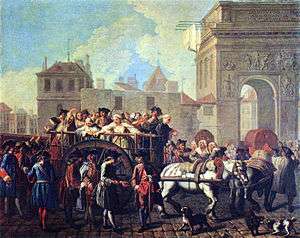Étienne Jeaurat

Étienne Jeaurat (9 February 1699, Vermenton – 14 December 1789, Versailles) was a French painter, above all remembered for his lively street scenes.[1]
Early life
Born in Vermenton near Auxerre, Jeaurat became an orphan at an early age. His brother, the engraver Edme Jeaurat, entrusted him to Nicolas Vleughels, a friend of Antoine Watteau, who was appointed director of the Académie de France in Rome in 1724. Vleughels took Jeaurat to Rome for an extended stay, exerting considerable influence on his work.[2]
Career
.jpg)
After returning to Paris, Jearat became a member of the Royal Academy in 1733. In 1737, he first exhibited at the Salon des Artistes at the Louvre, then not a museum but a palace. He continued to exhibit his work on a regular basis there until 1789. At the Academy, Jeaurat was elevated to professor (1737) and chancelier (1781) while he also became the guardian of the king's collection of paintings in Versailles from 1767. He achieved considerable success from his historical and mythological workss, his portraits and still lifes, often emulating the style of Chardin. But it was above all his genre paintings which attracted interest. He was particularly adept at painting lively scenes in the streets of Paris such as La Conduite des filles de joie à la Salpétrière, lorsqu'elles passent par la Porte St-Bernard (1755) showing prostitutes being transported to the Salpétrière prison. He also painted a series of eight works depicting scenes from La Fontaine's fables as well as religious works.[2][3]
Selected works

- Laban Searching his Daughters (1737), Oil on canvas, 15x33 cm, Hermitage Museum[4]
- Recovering (1744), Oil on canvas, 43.5x32.5 cm, Hermitage Museum[4]
- Interior with two Women (c 1740), Oil on canvas; 61 x 51 cm, Ashmolean Museum.
- Bain de femmes (1741), Oil on canvas, 64.5 x 52,5 cm, Musée de Bordeaux.[5]
- La Conduite des filles de joie à la Salpêtrière (1755), Musée Carnavalet
| Wikimedia Commons has media related to Étienne Jeaurat. |
References
- ↑ "Étienne Jeaurat", Encyclopédie Larousse. (French). Retrieved 26 April 2012.
- 1 2 "Turquerie - Etienne Jeaurat", Ville de Namur. (French) Retrieved 26 April 2012.
- ↑ "Ètienne Jeaurat", Art Directory. Retrieved 26 April 2012.
- 1 2 "Jeaurat", Hermitage Digital Collection. Retrieved 26 April 2012.
- ↑ "Etienne Jeaurat", Musée de Bordeaux. Retrieved 26 April 2012.